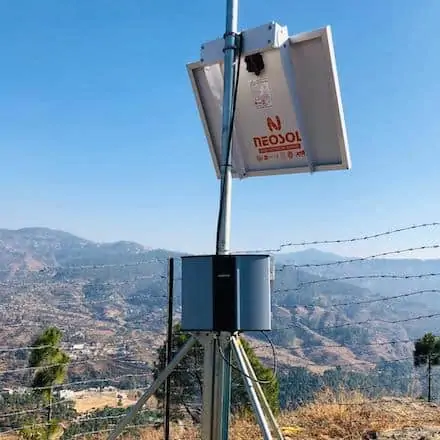How important is monitoring air quality in mountains?
Mountains – A source of freshwater, good quality air, flora and fauna, natural resources like wood, basic food, etc. The ambient air of mountains is so good that people forget their worries and spend a peaceful time. Because of this, mountain tourism has increased drastically in recent times. People like to spend their holidays under the arms of nature, away from the hustle-bustle of city life. People have a reason behind this and that is to inhale good air which they miss in the cities. But unknowingly, this reason itself leads to air pollution in mountains. These days mountains have become a hotspot for air pollution and hence monitoring air quality in mountains becomes key.
In this blog, we will discuss the reasons behind air pollution in mountains and how Oizom’s flagship solutions help in monitoring air quality in mountains. Apart from that, we will also take a look at the benefits of having good mountain air.
“Air pollution is turning Mother Nature prematurely gray“
Irv Kupcinet
Contributing factors of Air Pollution in Mountains
Lately, there is a rapid change in the mountain ecosystem. Air pollution in mountains, soil erosion, forest fires are some of the signs through which we observe this change. There are a few contributing factors that play a major role in air pollution in mountains. Let’s talk about them in detail:
Increasing mass tourism
Tourism is an important part when considering a country’s economy. Apart from that, people also like to take some time off from their busy city life and spend holidays peacefully under the natural beauty of mountains. This results in increasing tourism speedily. The World Counts shows the effect of tourism on the environment. Over there we can see how CO2 emissions have increased and will continue to surge as a result of an increase in tourism. This impacts the ambient air of mountains, thus leading to air pollution in mountains.
Vehicle emissions

For transportation, the best option considered is Heavy-duty trucks. Hence, when considering the transport of goods from the mountainous region, they come into the picture. But these vehicles are the reason for the exponential increase of toxic gases(like Nitrogen oxide, Carbon Monoxide) in the air. Apart from this, Particulate Matter(especially PM2.5, PM10) emitted from them has increased too. Thus, air pollution in mountains is the aftermath of these vehicular emissions.
Increasing garbage volume
Humans directly impact the garbage volume collected in mountainous regions. As their number increases so do the garbage size. Tourists come to enjoy their holidays and in return, they leave heaps of garbage behind them. Burning of the collected waste leads to the release of toxic gases in the air, thus decreasing the quality of ambient air in mountains. Apart from this, contamination of the street-side litter happens if not collected timely and thereby resulting in air pollution. Contaminated garbage releases harmful gas pollutants like methane, CO2, and unpleasant odour which causes various respiratory diseases.

Benefits of Good Mountain Air
Needless to say, mountains have better air quality than cities. We all know city air contains pollutants like nitrogen oxides(NOx), carbon oxides(COx), and other toxic gases. The concentration of PM2.5, PM10, and others is also higher in city air than mountain air. Because of these air pollutants, health concerns like asthma, chronic obstructive pulmonary disease (COPD), and other heart and lung diseases have increased in cities. Due to this, cities have lower life longevity. As mountains provide fresh air, people staying there have fewer health concerns. Studies have shown that living in mountains has lower chances of dying from Ischemic heart disease. Thus, life expectancy increases in the mountain region.
A good, fresh mountain air helps in promoting general well-being. Also, it helps in reducing stress-related illnesses like anxiety, depression. Apart from this, just inhaling the smell of mountain trees supports a good respiratory system. Other than this, mountain people have to worry less about metabolism-related concerns like obesity, blood sugar, high blood pressure, and cholesterol.
It is important to understand the quality of air that we inhale. As the air pollution in mountains is increasing gradually, steps to improve air quality should be given utmost importance. To take proper steps we need to understand the air quality data and for that air quality monitoring system needs to be installed. This is where Oizom plays an important role. Oizom’s flagship air quality monitoring solutions like Polludrone, Dustroid, Odosense help in identifying the mountain air quality levels on a real-time basis. This empowers the city or town or county authorities to take corrective measures in a timely manner.
How does Oizom help in monitoring air quality in mountains?
Nested within the Himalayan range, Almora gives ideal climatic conditions for year-round tourism. Every year, thousands of travellers, including backpackers and families visit here for their annual vacations. For instance, in 2019 alone, around 39 million tourists visited Uttrakhand. This created the importance of monitoring air quality in hills like Almora situated in Uttrakhand.
Partnering with MeaTech, Oizom’s Dustroid monitors vehicular pollution in Almora Hills. Real-time data collection was done through Dustroid. Installing an ambient dust monitor helped the authorities understand the trend of particulate matter pollution. The collected data was very insightful. It helped the local authorities manage tourists and reduce vehicular emissions causing minimum adverse effects to health, flora, and fauna.

To maintain the balance of the ecosystem, the air quality of mountains must become better. Not just the ecosystem will benefit from better air quality, humans too will get its benefit. Ambient air means fewer health concerns, longer life span. Oizom helps in achieving this target. For instance, installing Oizom’s air monitoring solutions at different crossroads & junctions helps in determining the pollutants. As a result, the concerned authorities will have a better understanding of the steps that need to be taken to improve air quality in mountains.






